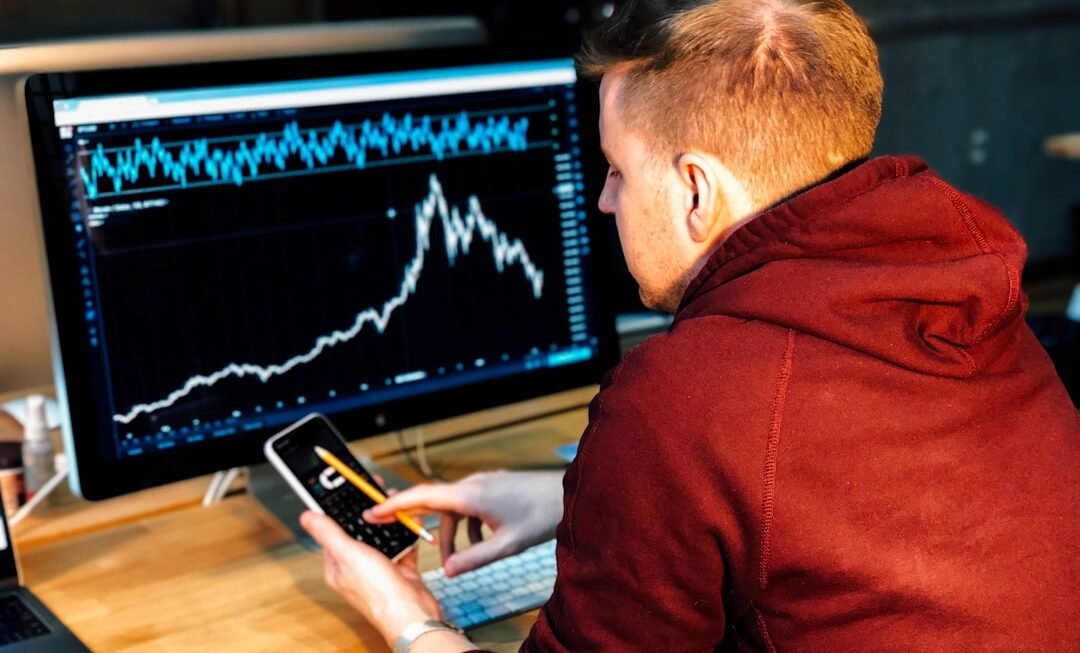The foreign exchange market, also known as the forex market, is the largest and most liquid financial market globally. It facilitates currency trading with an average daily trading volume exceeding $5 trillion. Operating 24 hours a day, five days a week, the forex market is decentralized, with no central exchange.
Instead, trading occurs over-the-counter (OTC) through a global network of banks, financial institutions, and individual traders. In forex trading, currencies are always traded in pairs, such as EUR/USD or GBP/JPY. When purchasing a currency pair, one is effectively buying one currency while selling another.
Exchange rates determine currency pair values, which fluctuate based on supply and demand, economic indicators, geopolitical events, and other factors. Traders can profit from these fluctuations by speculating on a currency pair’s value movement through buying (going long) or selling (going short) positions. To participate in the forex market, traders must use a forex broker, who serves as an intermediary between the trader and the interbank market.
Brokers provide trading platforms and market access, charging a small commission or spread on each trade. Selecting a reputable and regulated broker is crucial to ensure fund safety and fair trading conditions. With a fundamental understanding of forex market operations, traders can proceed to choose an appropriate online forex trading platform.
Choosing the Right Online Forex Trading Platform
Key Factors to Consider
When choosing a trading platform, it’s important to consider factors such as reliability, security, ease of use, and available technical analysis tools. One of the most popular trading platforms is MetaTrader 4 (MT4), which is known for its user-friendly interface and advanced charting capabilities. MT4 also supports automated trading through Expert Advisors (EAs), which are customizable trading algorithms that can execute trades on behalf of the trader.
Popular Trading Platforms
Another widely used platform is MetaTrader 5 (MT5), which offers additional features such as more timeframes, more technical indicators, and an economic calendar. Other popular trading platforms include cTrader, NinjaTrader, and TradingView. In addition to the trading platform itself, traders should also consider the quality of trade execution and the range of tradable instruments offered by the broker.
Evaluating Brokers and Developing a Trading Strategy
Some brokers may offer a wider selection of currency pairs, commodities, indices, and cryptocurrencies than others. It’s also important to consider the broker’s customer support, educational resources, and regulatory status. By carefully evaluating these factors, traders can choose a reliable and suitable online forex trading platform that meets their individual needs. Once a trading platform has been selected, traders can then focus on developing a solid trading strategy.
Developing a Solid Trading Strategy

A solid trading strategy is essential for success in the forex market. A trading strategy is a set of rules and criteria that guide a trader’s decision-making process, from identifying trade opportunities to managing risk and exiting trades. There are many different trading strategies that traders can use, ranging from simple to complex, and from short-term to long-term.
Some common trading strategies include trend following, range trading, breakout trading, and news trading. Regardless of the specific strategy used, it’s important for traders to have a clear understanding of their entry and exit criteria, as well as their risk management rules. This includes determining the size of each trade relative to the trader’s account balance (position sizing), setting stop-loss and take-profit levels to limit potential losses and lock in profits, and managing overall exposure to the market.
Traders should also consider factors such as market conditions, economic indicators, and geopolitical events when developing their strategy. In addition to having a solid trading strategy, traders should also backtest their strategy on historical data to ensure its effectiveness. Backtesting involves applying the trading strategy to past market data to see how it would have performed under real market conditions.
This can help traders identify any potential flaws or weaknesses in their strategy before risking real money. By developing and testing a solid trading strategy, traders can increase their chances of success in the forex market. However, even with a solid strategy in place, managing risk and emotions in forex trading is crucial for long-term profitability.
Managing Risk and Emotions in Forex Trading
Managing risk and emotions is one of the most challenging aspects of forex trading. The forex market is inherently volatile and unpredictable, and it’s easy for traders to let their emotions cloud their judgment. Fear, greed, and overconfidence can lead to impulsive decision-making and irrational behavior, which can result in significant losses.
Therefore, it’s important for traders to develop a disciplined approach to managing risk and controlling their emotions. One of the key principles of risk management is to never risk more than a small percentage of your trading account on any single trade. This helps to protect your capital from large losses and allows you to stay in the game even after a series of losing trades.
Traders should also use stop-loss orders to automatically exit losing trades at predetermined levels, as well as take-profit orders to lock in profits at favorable levels. By setting these orders in advance, traders can remove emotion from their decision-making process and stick to their trading plan. In addition to managing risk through position sizing and order placement, traders should also be mindful of their emotional state while trading.
This includes staying disciplined and patient during periods of market volatility, avoiding revenge trading after a loss, and not becoming overly attached to individual trades. It’s also important for traders to take breaks when feeling stressed or fatigued, as well as to maintain a healthy work-life balance. By managing risk and emotions effectively, traders can maintain a clear mindset and make rational decisions based on their trading strategy.
With risk management and emotional control in place, traders can then focus on utilizing technical and fundamental analysis to inform their trading decisions.
Utilizing Technical and Fundamental Analysis
Technical analysis and fundamental analysis are two primary methods used by forex traders to analyze the market and make informed trading decisions. Technical analysis involves studying historical price data and using various technical indicators to identify patterns and trends in the market. This can help traders predict future price movements and determine entry and exit points for trades.
Some common technical indicators used in forex trading include moving averages, RSI (Relative Strength Index), MACD (Moving Average Convergence Divergence), and Bollinger Bands. Fundamental analysis, on the other hand, involves analyzing economic indicators, geopolitical events, and other macroeconomic factors that can influence currency prices. This includes factors such as interest rates, inflation rates, GDP growth, employment data, central bank policies, and geopolitical tensions.
By staying informed about these fundamental factors, traders can gain insight into the underlying strength or weakness of a currency and make more informed trading decisions. While some traders may focus primarily on technical analysis or fundamental analysis, many successful traders use a combination of both approaches to inform their trading decisions. By integrating technical and fundamental analysis into their trading strategy, traders can gain a more comprehensive understanding of the market and increase their chances of making profitable trades.
However, even with effective analysis techniques in place, implementing effective money management techniques is crucial for long-term success in forex trading.
Implementing Effective Money Management Techniques

Key Components of Money Management
This includes determining the size of each trade relative to your account balance (position sizing), setting stop-loss and take-profit levels to limit potential losses and lock in profits, and managing overall exposure to the market.
Techniques for Managing Risk
One common money management technique used by forex traders is the 2% rule, which involves risking no more than 2% of your account balance on any single trade. This helps to protect your capital from large losses and allows you to stay in the game even after a series of losing trades. Traders should also consider using leverage cautiously, as it can amplify both profits and losses.
Additional Strategies for Success
In addition to position sizing and leverage management, traders should also consider diversifying their trading portfolio across different currency pairs and asset classes. This can help spread risk across multiple trades and reduce overall exposure to any single market or instrument. Regularly reviewing and adjusting your money management plan is also essential, as market conditions and risk tolerance can change over time.
Continuous Learning and Improvement in Forex Trading
Continuous learning and improvement are essential for long-term success in forex trading. The forex market is constantly evolving, with new trends, patterns, and strategies emerging over time. Therefore, it’s important for traders to stay informed about market developments and continuously expand their knowledge and skills.
One way to continue learning about forex trading is through educational resources such as online courses, webinars, books, and articles. Many reputable brokers offer educational materials for their clients to help them improve their trading skills. Traders can also benefit from joining online communities or forums where they can share ideas with other traders and learn from each other’s experiences.
In addition to expanding their knowledge base, traders should also regularly review their trading performance and identify areas for improvement. This may involve analyzing past trades to identify any recurring mistakes or weaknesses in their strategy. Traders should also stay informed about changes in market conditions or regulatory developments that may impact their trading approach.
By continuously learning and improving their skills as traders, individuals can adapt to changes in the market environment and increase their chances of long-term success in forex trading. This ongoing commitment to learning can help traders stay ahead of the curve and make informed decisions based on current market conditions. In conclusion, success in forex trading requires a solid understanding of the basics of the forex market, choosing the right online forex trading platform, developing a solid trading strategy, managing risk and emotions effectively utilizing technical and fundamental analysis implementing effective money management techniques continuous learning and improvement are essential for long-term success in forex trading.
By mastering these key aspects of forex trading individuals can increase their chances of making profitable trades while minimizing potential losses.












